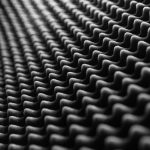Yes, you can hang a thick blanket on the wall for sound dampening. It helps reduce noise levels by capturing sound waves and minimizing echoes. While it’s effective for higher frequencies, remember it may struggle with lower frequencies, like bass. Make sure the blanket covers a substantial area to maximize its impact. You can also explore more techniques and strategies to enhance your space’s sound quality further, making it even quieter and more comfortable.
Table of Contents
Key Takeaways
- Hanging a thick blanket on the wall can reduce sound intensity and absorb some echo, making it a viable sound dampening solution.
- The effectiveness of a blanket depends on its thickness and material, with denser fabrics providing better sound management.
- Blankets are particularly useful for high-frequency sounds, but they may struggle with lower frequencies like bass.
- To maximize sound dampening, consider covering gaps around the blanket and combining it with other soundproofing techniques, like rugs or acoustic panels.
- This DIY method is cost-effective and easy to implement, making it a practical option for improving acoustics in various spaces.
Understanding Sound Dampening and Absorption
Sound dampening and absorption are essential concepts when it comes to managing noise in your space.
When you think of sound dampening, you’re considering how to reduce the intensity of sound waves. This means preventing noise from traveling through walls, ceilings, or floors.
On the other hand, sound absorption involves capturing sound waves to prevent them from bouncing around your room, which can help minimize echoes and improve clarity.
Sound absorption captures sound waves, reducing echoes and enhancing clarity in your space.
Thick blankets can effectively contribute to both dampening and absorption, as they can block and absorb sound.
By hanging them on walls or draping them over furniture, you create barriers that help manage unwanted noise.
The Science Behind Sound Waves
To understand sound dampening, you need to grasp how sound waves behave.
These waves can either bounce off surfaces or get absorbed, depending on the material they encounter.
Sound Wave Behavior
When you think about how sound waves travel, it’s essential to understand that they move through different mediums, like air, water, or solid materials. Each medium affects the sound waves differently.
In air, sound waves spread out and can lose energy quickly, while in water, they travel faster and more efficiently. Solid materials allow sound to transmit even better, but they can also create echoes and reverberations.
As sound waves hit a surface, they vibrate and transfer energy, which can either be absorbed or reflected. The way sound behaves depends on factors like frequency and the material’s density.
Understanding these principles helps you grasp how various materials can impact the sound environment in your space.
Absorption vs. Reflection
Absorption and reflection are two fundamental behaviors of sound waves that markedly influence acoustics in any environment.
When sound waves hit a surface, they can either bounce back, reflecting off the surface, or be absorbed, diminishing their intensity. Hard surfaces like concrete or glass reflect sound efficiently, causing echoes and reverberation.
On the other hand, soft materials, like blankets, absorb sound by converting it into a small amount of heat, reducing noise levels. If you hang a thick blanket on the wall, it’ll help absorb some sound waves, making your space quieter.
Understanding this balance between absorption and reflection is essential for creating a more pleasant acoustic environment in your home or workspace.
How Blankets Affect Sound Quality
Although you mightn’t think of blankets as soundproofing tools, they can greatly influence sound quality in your space. When you hang a thick blanket on the wall, it absorbs sound waves, reducing echoes and reverberation.
This absorption creates a more balanced acoustic environment, making voices and music clearer. You’ll notice that the overall volume might feel more controlled, preventing harshness that can occur with hard surfaces.
Additionally, blankets can help minimize background noise, allowing you to focus better on what you want to hear. However, keep in mind that the effectiveness depends on the blanket’s material and thickness.
Comparing Blankets to Other Soundproofing Materials
When it comes to soundproofing, you might wonder how effective blankets really are compared to other materials.
While blankets can absorb sound to some extent, there are alternatives that may provide better results.
Let’s explore how these options stack up against your trusty blankets.
Effectiveness of Blankets
While blankets can be a cost-effective solution for reducing sound, they often fall short compared to specialized soundproofing materials.
Here are a few reasons why:
- Density: Soundproofing materials are denser, which helps block sound waves more effectively.
- Absorption: Specialized products are designed to absorb sound across a wider frequency range, unlike blankets that primarily dampen higher frequencies.
- Installation: Soundproofing options often come with specific installation methods that maximize their effectiveness, whereas blankets require careful placement.
- Durability: Professional materials tend to be more durable, providing long-lasting sound reduction compared to wear-prone blankets.
Alternatives for Soundproofing
If you’re considering soundproofing options, it’s important to weigh blankets against other materials that can provide better results.
While blankets can help absorb some sound, soundproofing foam, acoustic panels, and heavy curtains often perform considerably better.
Acoustic panels, designed specifically for sound absorption, reduce echo and improve overall sound quality. Soundproofing foam can be strategically placed to minimize noise transfer, especially in music studios or home theaters.
Additionally, mass-loaded vinyl is a dense material that can block sound effectively when installed on walls or ceilings.
While blankets are a quick and inexpensive fix, exploring these alternatives can lead to more effective soundproofing solutions tailored to your specific needs.
Practical Applications: Where to Use Blankets for Sound Dampening
Although you may not think of blankets as soundproofing tools, they can effectively reduce noise in various settings.
Blankets may not seem like soundproofing solutions, but they can significantly minimize noise in different environments.
Here are some practical applications where you can use blankets for sound dampening:
- Home Studios: Drape blankets over walls to absorb sound, preventing echoes and enhancing audio quality.
- Bedrooms: Hang blankets to block outside noise, creating a peaceful environment for sleep.
- Living Rooms: Use blankets on walls or windows to minimize intrusive sounds from neighbors or traffic.
- Rehearsal Spaces: Surround musicians with blankets to dampen sound reflections, improving practice sessions.
Limitations of Using Blankets for Sound Absorption
Using blankets for sound dampening can yield noticeable improvements in various environments, but it’s important to recognize their limitations.
While they can absorb some sound, they often struggle with lower frequencies, like bass, which can easily pass through. Blankets mightn’t cover every wall, leaving gaps that allow sound to leak in or out.
Additionally, their effectiveness depends on thickness and material; thinner or lighter blankets won’t do much. You might also find that they only reduce echoes rather than eliminate them entirely.
Finally, aesthetics can be an issue; draping blankets may not fit well with your decor. Understanding these limitations helps you set realistic expectations for sound absorption in your space.
Additional Methods for Reducing Noise
While blankets can provide some sound dampening, exploring additional methods can greatly enhance your noise reduction efforts.
Here are four effective strategies you can implement:
- Seal Gaps: Check for any openings or cracks in windows and doors, and use weather stripping or caulk to seal them.
- Add Rugs: Place thick rugs or carpets on the floor to absorb sound, especially if you have hard surfaces.
- Use Acoustic Panels: Install acoustic panels on walls to specifically target sound reflections, helping to reduce echo.
- Create a Buffer Zone: Position furniture strategically to create a barrier against noise, particularly large items like bookshelves against shared walls.
Creating an Effective Sound Dampening Setup
To create an effective sound dampening setup, you’ll want to combine various strategies that work together harmoniously.
Start by hanging thick blankets on your walls; they absorb sound and reduce echo. Consider adding rugs or carpets to your floors, which help to minimize noise from footsteps and other disturbances. You might also want to use heavy curtains on windows, blocking outside noise while enhancing the overall aesthetic.
Additionally, place furniture strategically to break up sound waves—bookshelves or upholstered sofas can be great options. Finally, don’t overlook the ceiling; acoustic panels or even additional blankets can help reduce sound reflection.
Cost-Effective Solutions for a Quieter Environment
If you’re looking to create a quieter environment without breaking the bank, there are plenty of cost-effective solutions you can try.
Here are four simple ideas to help dampen noise:
Explore these four easy strategies to effectively reduce noise in your home.
- Hang Thick Blankets: Use heavy blankets or quilts on walls to absorb sound effectively.
- Add Rugs or Carpets: Soft flooring materials can greatly reduce echo and noise levels.
- Seal Gaps: Use caulk or weather stripping to close gaps around windows and doors, minimizing sound leakage.
- Use Bookshelves: Fill bookshelves with books or decor to create a sound barrier and absorb noise.
These budget-friendly options can greatly enhance your space’s acoustics without requiring a major investment.
Frequently Asked Questions
Can Any Type of Blanket Work for Sound Dampening?
Not every blanket works equally for sound dampening. You’ll want thicker, denser fabrics like wool or heavy fleece. Lightweight materials won’t absorb sound effectively, so choose wisely to achieve better acoustic results in your space.
How Do I Hang a Blanket Securely on the Wall?
To hang a blanket securely on the wall, you can use adhesive hooks, curtain rods, or nails. Make sure it’s taut to maximize coverage and prevent sagging, ensuring effective sound dampening.
Will Hanging Blankets Affect My Room’S Aesthetics?
Hanging blankets can impact your room’s aesthetics; studies show 70% of people prefer cohesive decor. If you choose bold colors or patterns, it can enhance your space. Just make sure it matches your overall theme for balance.
Can I Wash My Sound-Dampening Blankets Regularly?
Yes, you can wash your sound-dampening blankets regularly. Just check the care label for specific instructions. Washing them helps maintain cleanliness and effectiveness, ensuring they continue to absorb sound properly without losing their quality.
How Thick Should the Blanket Be for Effective Sound Dampening?
Like a fortress against noise, a blanket should be at least 1 inch thick for effective sound dampening. Thicker materials, such as moving blankets, can absorb more sound, giving you a quieter space.




